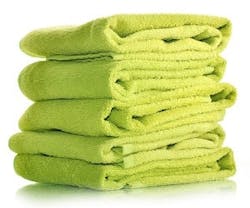10 Facts about Green Standard GS-51
GS-51 is a new standard designed to address the life cycle impacts of laundry care products used in institutional and industrial settings.
This standard covers more than 20 product categories for conventional laundry and dry cleaning, including detergents, prewash products, spot removers, laundry additives, fabric care products, and more.
According to Linda Chipperfield, vice president of marketing and communications for Green Seal, GS-51 represents a comprehensive benchmark for sustainable laundry care products.
"It also provides manufacturers [with] the opportunity to be recognized as leaders in the industry," says Chipperfield, "and allows purchasers to identify safer, environmentally preferable laundry products."
Like all Green Seal standards, GS-51 sets clear sustainability criteria based on strict scientific definitions.
In order to educate facilities managers, laundry service providers, and the public about the new standard, Green Seal is releasing the following Top Ten Facts about GS-51. The standard:
1. Covers a wide variety of laundry care products
2. Includes performance requirements to ensure that products meet consumer expectations
3. Requires that detergents and softeners be concentrated to reduce packaging and transport needs and to minimize greenhouse gas emissions
4. Prohibits ingredients that are known carcinogens, mutagens, reproductive toxins, and other health hazards
5. Lessens the risk that product users will inhale volatile organic compounds (VOCs) and asthmagens
6. Helps protect product users from damage to skin or eyes
7. Requires that products be nontoxic to human and aquatic life and contain biodegradable ingredients
8. Requires that product packaging be reduced and made from recyclable materials with postconsumer content; or be refillable/returnable
9. Mandates ingredient disclosure, including fragrance components, to promote transparency
10. Requires that producers provide product users with training instruction regarding proper dilution and dosing
